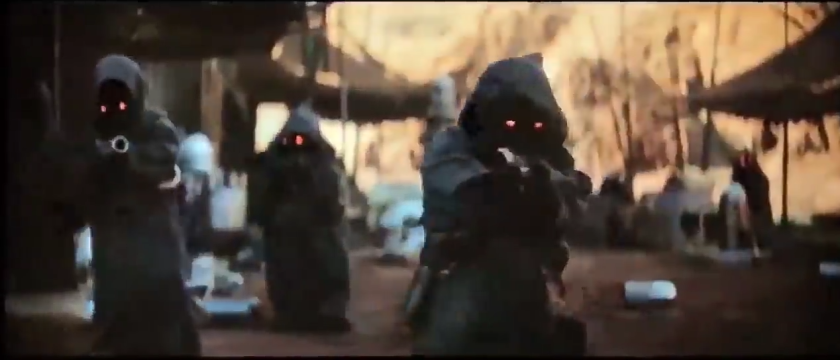When Star Wars: The Force Awakens was released, I wrote about the realities of the junk market on Jakku and the difficulties Rey would have had to eek out an existence in the war-torn desert planet. Now that Jawas played a prominent role in the second episode of The Mandalorian, I’m thinking even more about junking.
Hey, Jawas work the junk market. And whereas Rey led an isolated, lonely existence, the Jawas were part of an active ecosystem of trading and swapping. So let’s explore that for a bit.

Jawas dealing in second-hand items is more social and networked than that of an eBay seller. It’s more like a picker and the flea market. And, let’s be honest, every thing us Americans know about picking, we learned from the television show American Pickers on the History Channel.
American Pickers follows antique and collectible scavengers Mike Wolfe and Frank Fritz, who travel around the United States to “pick” unique items for resale. While on the road, the men follow leads or sometimes “free-style”, which is to stop at a place that looks like it is ripe for the picking, holding items that are worth buying.
Unlike the Jawas, who use a huge Mandalorian-proof mobile fortress called a sandcrawler, Mike and Frank travel around in a Mercedes-Benz Sprinter van. From the show’s intro:
I’m Mike Wolfe. And I’m Frank Fritz. And we’re pickers. We travel the back roads of America looking to buy rusty gold. We’re looking for amazing things buried in people’s garages and barns. What most people see as junk, we see as dollar signs. We’ll buy “anything” we think we can make a buck on. Each item we pick has a history all its own. And the people we meet? Well, they’re a breed all their own. We make a living telling the history of America…one piece at a time.
For a Jawa, a dinged up astromech droid and a protocol droid that has lost its luster are prime picks. One person’s junk is another Jawa’s treasure. All they need to do is find the right buyer, hoping the droid doesn’t blow its lid before they’ve taken the credits. But with their sand crawlers, Jawas are able to present a sort of mobile flea market, bringing the salvage direct to the customer.
American flea markets are a 30 billion dollar a year industry, according industry reports. The United States’ 1,100 flea markets consist of upwards of 2.25 million vendors and attract an estimated 150 million customers each year! Although, I haven’t been able to confirm if any droids have been bought and sold in the U.S.
If those numbers seem large for something that might not be on your radar, it’s understandable. Few individual flea market vendors utilize the internet or social media for any kind of marketing. Of vendors surveyed, 60% do not have any social media presence at all. 82% of flea market vendors don’t have a website and report that they don’t plan on ever having one.
Instead, the American flea market industry is built on tradition and community. For most market shoppers there persists an expectation of finding bargains and old fashioned items at flea markets. Lorna Ingersoll, great-granddaughter of the founder of Jamie’s Flea Market, expresses, “Flea markets are still traditional, and that’s what people love.” It’s almost like Uncle Owen knew what to expect from the Jawas.

The stability of the Americant flea market can be attributed to the dedicated veterans of the industry. 70% of American flea markets have been open for over 20 years. Over half of vendors sell at just a few locations, demonstrating a sense of loyalty to their market and its community.
Ben Campen, the National Flea Market Association President, says flea markets, “create a family. We have groups of people who have been vending with us ever since we started. There’s this one group of ten vendors, who have all been together since the mid ’80s. If it’s someone’s birthday, they’ll have a big party. They do their own potlucks on Sundays. It’s nice to see this family that has been created. This is a business, but it’s also a social thing too.”
Vendors describe the relationships that are built at flea markets as unique. Those who become involved in markets all have one thing in common: “People who are looking for the American Dream,” says Campen. “Flea markets provide that avenue for people to be successful and stand on their own two feet. People enjoy hearing stories of how others got in the business and success stores; it’s encouraging.”
Me? I just like to occasionally visit flea markets to see if I can find some old comics or vintage GI Joe figures or something. But when you think about the statistics of flea markets and how so many of their regulars stick together through thick and thin, it’s easy to become a little envious of the bonds they clearly have for one another. Good for them; the world need more of that sort of thing.
What of the Jawas who had built a well-worn sand crawler trail from one Tatooine settlement to the next? Unlike the Tusken Raiders who were feared, it was clear that the Jawas were seen as respectable and valued merchants in the community, even if you knew to ask the right questions regarding the dependability of their merchandise.
So, I like to think that the Jawas had a stable, cohesive community inside those sand crawlers of theirs. I hope that amongst all the junk and the picks, that it was filled with friendship, community, and the Tatooine Dream.

